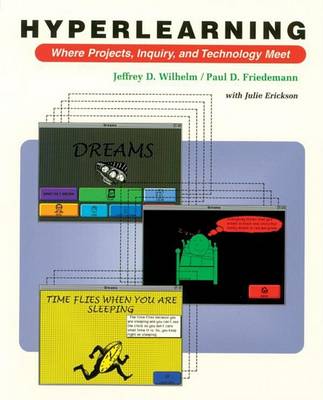"You know, before this, I thought research was like going to the library and just copying things down and then handing in a report or reading it to someone. This hypermedia stuff we're doing makes me see that research is real work and that you have to learn things from lots of angles, and you have to actually create new knowings. Like, WOW, man!"
Mike, an eighth graderMike is talking about documenting his learning with hypermedia, a way of presenting text in nonlinear, multimedia form on "cards" or computer screens. Graphics, photos, drawings, video, music, speech, or animation can all be included with text on cards and linked or connected to other cards through the use of "buttons." The stacks of cards containing verbal and graphic text can then be manipulated, read, and navigated in a variety of ways to explore different associations and pursue varying lines of inquiry.
Using hypermedia does not require technological expertise or a classroom full of the latest hardware and expensive software. Readily available programs like HyperCard(r) and HyperStudio(r) are self-tutoring and easy to learn and run even on the older, slower computers. This book explores how kids can be assisted to master the technology while teachers support their reading, learning, and a wide array of inquiry skills.
Through their own classroom stories and research, the authors explore how they taught hypermedia skills within the context of real and personally relevant middle school classroom projects. They found that using hypermedia:
is motivating and effective with all students, particularly those who are labeled or considered at risk;makes learning visible and accountable;supports students in achieving better reading and writing skills, in developing ideas, in doing organized, productive research, and in applying critical standards to their work;is applicable in all content areas and grade levels and not tied to any one particular program or software.Hyperlearning is for teachers, educational psychologists, curriculum developers, and technology coordinators who are seeking new ways to support the attainment of both rich conceptual learning and more powerful procedures for learning, reading, and composing. And it is particularly relevant for administrators interested in improving technology use in schools.
If you want to get immediately into hypermedia, you should checkout this link to Paul Friedemann's web site: www.nconnect.net/ frito. There you'll find a rich variety of information, including links to hypermedia sites, questions and comments on hypermedia and technology, teaching resources on the web, and much more detail about this book.
- ISBN10 1571100547
- ISBN13 9781571100542
- Publish Date 1 January 1998
- Publish Status Out of Stock
- Out of Print 28 June 2011
- Publish Country US
- Imprint Stenhouse Publishers
- Format Paperback
- Pages 184
- Language English
